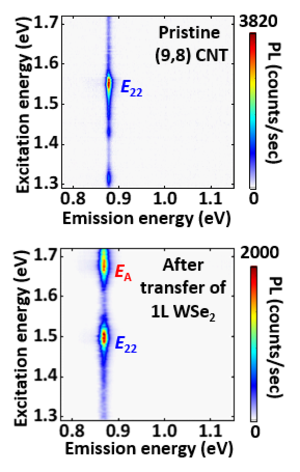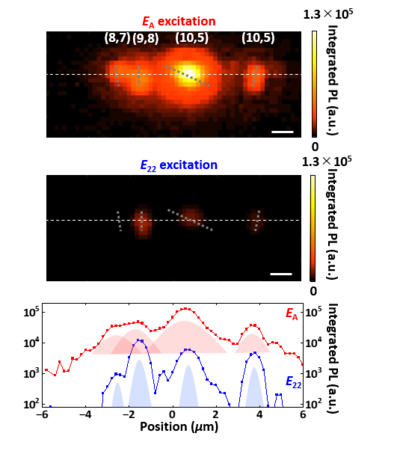Research:Resonant exciton transfer in mixed-dimensional heterostructures
Nanomaterials such as carbon nanotubes (CNTs) exhibit unique optical phenomena, in particular excitonic quantum processes occurring at room temperature. The low dimensionality, however, imposes strict requirements for conventional optical excitation. Spatially, the diameter of a single-walled CNT is ≈1 nm, which is considerably smaller than the diffraction-limited diameter of ≈1 μm for incident laser light. This pronounced size difference restricts the interaction area between CNTs and light, inherently leading to a limited number of photons absorbed. Spectrally, the isolated E11 and E22 transitions in the absorption spectrum necessitate wavelength-tunable lasers to excite CNTs of the desired chirality. Furthermore, the 1D confinement of excitons in CNTs results in nearly perfect linear excitation polarization dependence, requiring the polarization angle to be aligned with the nanotube axis.
Here we report on exciton transfer in carbon nanotube/tungsten diselenide (WSe2) heterostructures, which provides an approach for bypassing such restrictions. The heterostructure is prepared in a manner similar to CNT/h-BN heterostructures utilizing the anthracene-assisted transfer technique.

Photoluminescence excitation (PLE) spectroscopy provide evidence for the exciton transfer process. A PLE map from a pristine suspended (9,8) CNT before the transfer show single main peaks for each of the excitation and emission energies corresponding to E22 and E11 transitions, respectively. After transferring a monolayer WSe2 flake, a prominent high-energy peak appears at ≈1.673 eV in the excitation dependence, which is a signature of the exciton transfer process.

With relaxed optical selection rules and pronounced exciton reservoir effects, the A exciton based excitation has a more distinct effect on an array of CNTs. The array under investigation comprises of four tubes located from left to right with chiralities of (8,7), (9,8), (10,5), and (10,5), and is covered by a monolayer flake. The excitation at the EA energy results in high intensity PL from all tubes and a quasi-2D excitation image spanning the trench. The line profile shows spatially continuous emission over 10 μm, resulting from overlapping tube images enlarged by exciton diffusion. In comparison, under E22 excitation, tube images are completely isolated. Furthermore, the (8,7) tube is unnoticeable since the excitation energy is detuned from its E22 energy and the polarization angle is misaligned. In general, achieving simultaneous excitation across all tubes remains a challenge due to different E22 energies and varying angles amongst the CNTs.

To learn more about this work, please refer to:
Resonant exciton transfer in mixed-dimensional heterostructures for overcoming dimensional restrictions in optical processes
Nature Commun.
14, 8152 (2023).
![]()